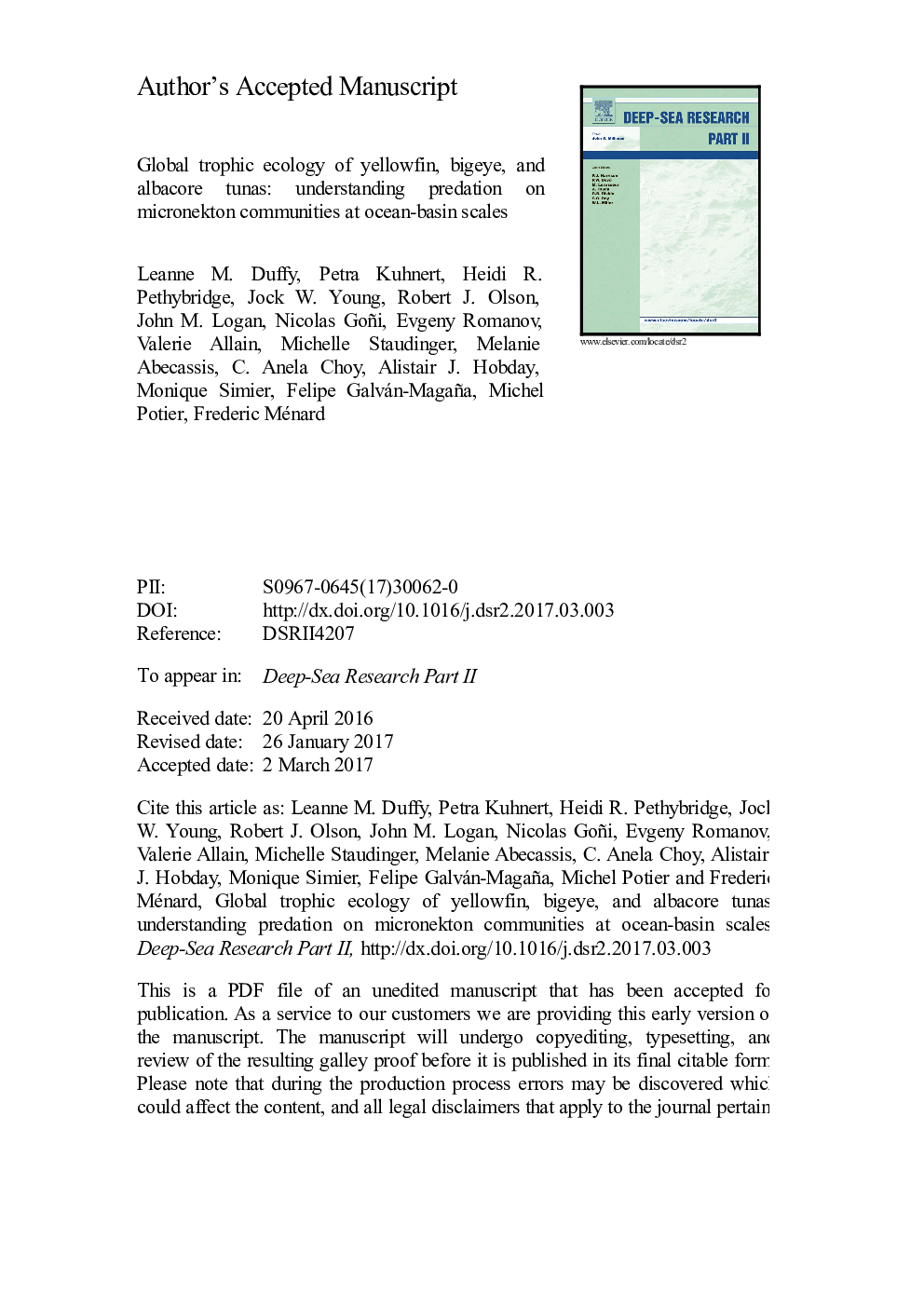| کد مقاله | کد نشریه | سال انتشار | مقاله انگلیسی | نسخه تمام متن |
|---|---|---|---|---|
| 5764951 | 1626402 | 2017 | 59 صفحه PDF | دانلود رایگان |
عنوان انگلیسی مقاله ISI
Global trophic ecology of yellowfin, bigeye, and albacore tunas: Understanding predation on micronekton communities at ocean-basin scales
ترجمه فارسی عنوان
بوم شناسی جهانی تونس زردآلو، باگیاه و بلند گوسفند: درک مقابله با جوامع میکرونکتون در مقیاس اقیانوس-حوضه
دانلود مقاله + سفارش ترجمه
دانلود مقاله ISI انگلیسی
رایگان برای ایرانیان
کلمات کلیدی
متاآنالیز، شبکه های غذایی، اکوسیستم، مقایسه بین اقیانوس، روابط طلایی، درختان طبقه بندی تغییرات اقلیمی، مکروکولوژی،
موضوعات مرتبط
مهندسی و علوم پایه
علوم زمین و سیارات
زمین شناسی
چکیده انگلیسی
Predator-prey interactions for three commercially valuable tuna species: yellowfin (Thunnus albacares), bigeye (T. obesus), and albacore (T. alalunga), collected over a 40-year period from the Pacific, Indian, and Atlantic Oceans, were used to quantitatively assess broad, macro-scale trophic patterns in pelagic ecosystems. Analysis of over 14,000 tuna stomachs, using a modified classification tree approach, revealed for the first time the global expanse of pelagic predatory fish diet and global patterns of micronekton diversity. Ommastrephid squids were consistently one of the top prey groups by weight across all tuna species and in most ocean bodies. Interspecific differences in prey were apparent, with epipelagic scombrid and mesopelagic paralepidid fishes globally important for yellowfin and bigeye tunas, respectively, while vertically-migrating euphausiid crustaceans were important for albacore tuna in the Atlantic and Pacific Oceans. Diet diversity showed global and regional patterns among tuna species. In the central and western Pacific Ocean, characterized by low productivity, a high diversity of micronekton prey was detected while low prey diversity was evident in highly productive coastal waters where upwelling occurs. Spatial patterns of diet diversity were most variable in yellowfin and bigeye tunas while a latitudinal diversity gradient was observed with lower diversity in temperate regions for albacore tuna. Sea-surface temperature was a reasonable predictor of the diets of yellowfin and bigeye tunas, whereas chlorophyll-a was the best environmental predictor of albacore diet. These results suggest that the ongoing expansion of warmer, less productive waters in the world's oceans may alter foraging opportunities for tunas due to regional changes in prey abundances and compositions.
ناشر
Database: Elsevier - ScienceDirect (ساینس دایرکت)
Journal: Deep Sea Research Part II: Topical Studies in Oceanography - Volume 140, June 2017, Pages 55-73
Journal: Deep Sea Research Part II: Topical Studies in Oceanography - Volume 140, June 2017, Pages 55-73
نویسندگان
Leanne M. Duffy, Petra M. Kuhnert, Heidi R. Pethybridge, Jock W. Young, Robert J. Olson, John M. Logan, Nicolas Goñi, Evgeny Romanov, Valerie Allain, Michelle D. Staudinger, Melanie Abecassis, C. Anela Choy, Alistair J. Hobday, Monique Simier,
